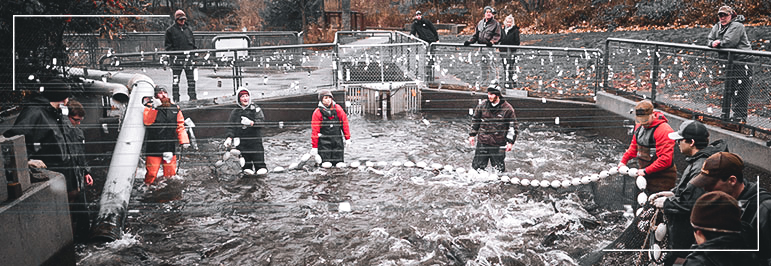Fisheries and Aquaculture Sciences

Fisheries and Aquaculture Techniques - Certificate
Want to fast-track your education? The Fisheries & Aquaculture Techniques Certificate focuses on applied, technical skill development in just nine months to maximize learning with a minimal time commitment. This certificate is ideal for students exploring new career pathways, established industry members desiring additional training, or those wishing to supplement their bachelor’s degree with hands-on experience.
Certificate students wishing to learn more advanced topics for higher employment placement may apply all Fisheries & Aquaculture Techniques certificate course credits towards an AAS or AAS-T in Fisheries & Aquaculture Sciences. Upon completion of the Fisheries & Aquaculture Techniques Certificate, students also receive the Aquaculture Science Certificate of Completion.
Employment Information
Data are provided on a program (not credential) level
71% BTC graduate placement rate1
$49,303 starting annual wage2
$56,597 average annual wage2
$66,348 potential annual wage2
Entry Information
When Can I Start?
This program typically starts in Fall quarter.
What are the Minimum Entry Requirements?
A completed college admissions application and placement in English and Math. BTC uses a Guided Self-Placement process to help you choose the best starting point for your English and Math courses. Your selections will determine whether you begin with program coursework or complete prerequisites classes first.
To get started or for help determining your English and math placement, contact the Outreach department at Outreach@btc.edu
What are My Next Steps?
Classes
Total Program Credits: 40
Core Courses for Program
AQUA 121 Principles of Aquaculture 5 CR TOTAL Core Courses for Program Credits 5 CR Program Specialty
AQUA 234 Fish Culture Practicum: Winter 1 CR AQUA 233 Fish Culture: Broodstock & Early Life 2 CR AQUA 235 Aquaponics 2 CR AQUA 236 Fish Culture: Nutrition & Health 2 CR AQUA 237 Fish Culture Practicum: Spring 1 CR AQUA 241 Fisheries Stock Enhancement 2 CR AQUA 242 Fisheries Stock Enhancement Practicum 3 CR AQUA 252 Aquaculture Management 5 CR TOTAL Program Specialty Course Credits 18 CR Electives
Elective Courses (Select any from this list.) AQUA 131 Aquatic Chemistry with Lab 5 CR AQUA 141 Research Methods 3 CR AQUA 201 Aquaculture Internship I 6 CR AQUA 271 Data Analysis for Aquatic Sciences 5 CR AQUA 272 Introduction to GIS 5 CR AQUA 273 Animal Genetics with Lab 5 CR AQUA 274 Organismal Biology with Lab 5 CR BUS& 101 Introduction to Business 5 CR BUS& 201 Business Law 5 CR ECON& 201 Micro Economics 5 CR ENGR& 104 Introduction to Engineering & Design 5 CR TOTAL Electives Course Credits 17 CR
Program Outcomes
Students who successfully complete the Fisheries & Aquaculture Techniques Certificate will be able to:
- Demonstrate competency in hatchery methods and apply appropriate techniques to spawn, incubate, rear, and release fish.
- Demonstrate competency in shellfish hatchery and aquaculture methods and apply appropriate techniques to raise diatoms, spawn shellfish, set seed, plant seed, culture and harvest shellfish.
- Demonstrate competency in Habitat Restoration methods and apply techniques to improve and restore habitat, plant native vegetation, eliminate invasive species, and add woody debris and gravel to streams.
- Demonstrate competency in field research, stream surveys, tag studies, spawning assessments, and smolt trap projects.
Employment Outlook
Fisheries & Aquaculture Techniques Certificate graduates meet the requirements for Fish Hatchery Technician positions with WDFW and Biological Technician GS 3 positions with the federal government, and employment in tribal government, private, and nonprofit sectors.
Faculty & Support

Brittany Palm
Fisheries & Aquaculture Sciences
Sara Smith
Fisheries & Aquaculture Sciences
Kai Rick
Hatchery Operations Specialist
Steeve Pomerleau
Fisheries & Aquaculture
Kai Rick
Hatchery Operations Specialist
Steeve Pomerleau
Fisheries & AquacultureContacts
If you have questions about this program or want help with the admissions steps to Bellingham Technical College, please email outreach@btc.edu.
Current students wanting academic planning and support, can connect with the program Instructor(s) or email FisheriesNav@btc.edu
